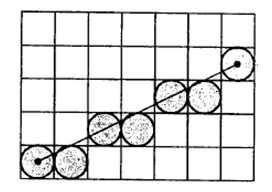Introduction of Aliasing in Graphics Multimedia
- Aliasing in Graphics Multimedia is one of the fundamental tools to smooth the image or shape or object.
Definition of Aliasing in Graphics Multimedia
- Aliasing is a phenomenon that occurs in computer graphics when a high-resolution image or shape is displayed on a low-resolution screen or output device. It results in jagged, pixelated edges or uneven lines, also known as “jaggies.”
- Aliasing in computer graphics refers to the visual distortion that occurs when displaying a digital image that has been sampled or rendered at a lower resolution than the display device. This can result in jagged edges or other visual artifacts in the image.
Features of Aliasing in Graphics Multimedia
- Aliasing occurs because digital images are made up of a finite number of pixels, which can only represent a limited range of colors and shapes. When an image is displayed on an output device (such as a monitor or screen) that has a higher resolution than the image itself, the screen must interpolate the image or shape to fill in the missing pixels. This interpolation can create visual artifacts that are not present in the original image.

- A Raster system is capable of displaying more than two intensity levels in their objects or images (color and grayscale), so we can apply antialiasing methods to modify pixel intensities. By appropriately varying the intensities of pixels along the line or object boundaries, we can smooth the edges to lessen the stair step or the jagged appearance of the raster image.
Anti-aliasing
-
Anti-aliasing is a technique used to reduce the effects of aliasing in computer graphics.
-
It works by smoothing out the jagged edges of an image/shape or by adding additional pixels of intermediate colors along the edges or by blending adjacent pixels, or supersampling, which involves rendering the image at a higher resolution than the display device and then downsampling it to create a smoother image. The other anti-aliasing techniques may include using higher-quality texture maps or using higher-quality filtering algorithms to smooth out the image.
-
This makes the edges appear smoother and less jagged, creating a more accurate representation of the original image or shape.
-
Different anti-aliasing techniques are used in different applications, such as MSAA (multi-sample anti-aliasing), SSAA (super-sample anti-aliasing or PostFiltering), and FXAA (fast approximate anti-aliasing), each with its own strengths and weaknesses.
-
Supersampling or Postfiltering
-
It is the process by which aliasing effects in graphics are reduced by increasing the frequency of the sampling grid and then averaging the results down.
-
This process means calculating a virtual image at a higher spatial resolution than the frame store resolution and then averaging it down to the final resolution.
-
It is called Postfiltering as the filtering is carried out after sampling.
- It involves increasing the sampling grid frequency and averaging down the results.
-
This technique calculates a higher spatial resolution virtual image and then filters it after sampling.
-
The three-stage process of supersampling includes sampling a continuous image at a higher resolution, lowpass filtering the virtual image, and resampling it at the final frame resolution.
-
Supersampling is a three-stage process:-
-
A continuous image Img(x, y) is sampled at n times the frame resolution. This is a virtual image.
-
The virtual image is then lowpass filtered.
-
The filtered image is then resampled at the final frame resolution.
-
-
-
![]()
0 Comments